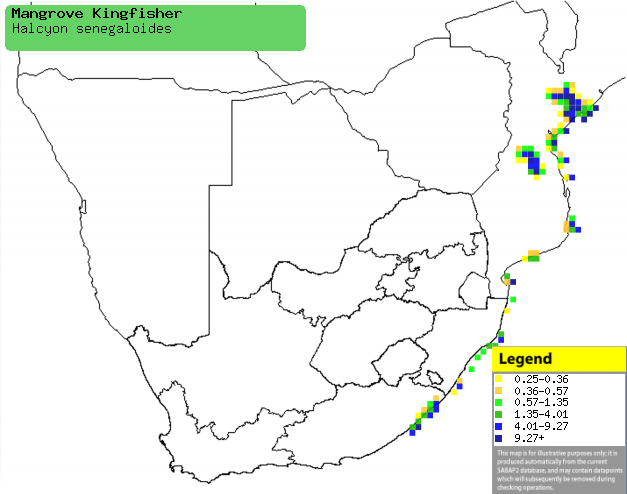|
Halcyon senegaloides (Mangrove kingfisher)
Manglietvisvanger [Afrikaans]; uNongozolo [Zulu]; Mangrove-ijsvogel
[Dutch]; Martin-chasseur des mangroves [French]; Mangroveliest [German]; Pica-peixe-dos-mangais
[Portuguese];
Life
> Eukaryotes >
Opisthokonta
> Metazoa (animals) >
Bilateria >
Deuterostomia > Chordata >
Craniata > Vertebrata (vertebrates) > Gnathostomata (jawed
vertebrates) > Teleostomi (teleost fish) > Osteichthyes (bony fish) > Class:
Sarcopterygii (lobe-finned
fish) > Stegocephalia (terrestrial
vertebrates) > Tetrapoda
(four-legged vertebrates) > Reptiliomorpha > Amniota >
Reptilia (reptiles) >
Romeriida > Diapsida > Archosauromorpha > Archosauria >
Dinosauria
(dinosaurs) > Saurischia > Theropoda (bipedal predatory dinosaurs) >
Coelurosauria > Maniraptora > Aves (birds) > Order: Coraciiformes
> Family: Dacelonidae
Distribution and habitat
Occurs along the east coast of sub-Saharan Africa, from
southern Somalia through Kenya and Tanzania to southern Africa. Within southern
Africa it is
uncommon in central and southern Mozambique, the coast of KwaZulu-Natal and
adjacent Eastern Cape. In summer it generally prefers the banks of forested
rivers, streams and estuaries along or near the coast, while in winter it mainly
stays in mangroves and nearby woodland.
|
 |
|
Distribution of Mangrove kingfisher in southern
Africa, based on statistical smoothing of the records from first SA Bird
Atlas Project (©
Animal Demography unit, University of
Cape Town; smoothing by Birgit Erni and Francesca Little). Colours range
from dark blue (most common) through to yellow (least common).
See here for the latest distribution
from the SABAP2. |
Movements and migrations
It is thought to at least be a partial migrant
in South Africa, breeding in the Eastern Cape from August-June,
after which it heads to KwaZulu-Natal for the non-breeding season.
Food
Mainly eats insects, other invertebrates and fish, doing
most of its foraging from a tree perch, descending to the ground or water to
catch prey before returning to its perch to feed. The following food items have been recorded
in its diet:
- Invertebrates
- Vertebrates
Breeding
- Monogamous and territorial, nesting solitarily in a hole in a tree or
riverbank (rarely), or alternatively using the old nest of a
woodpecker or
barbet.
- Egg-laying season is from October-January in the Eastern Cape.
- It lays three eggs, which are probably incubated solely by the female,
who is fed by the male at the nest.
- The chicks are fed by both parents, but nothing else is known about
their development and care.
Threats
Vulnerable in South Africa, partly due its small,
isolated breeding population in the Eastern Cape, which is threatened by habitat
destruction.
References
-
Hockey PAR, Dean WRJ and Ryan PG 2005. Roberts
- Birds of southern Africa, VIIth ed. The Trustees of the John Voelcker
Bird Book Fund, Cape Town.
|
